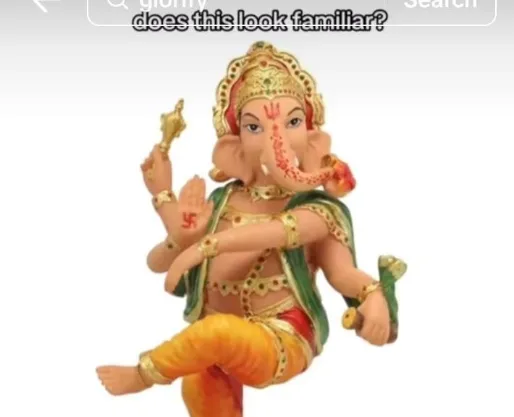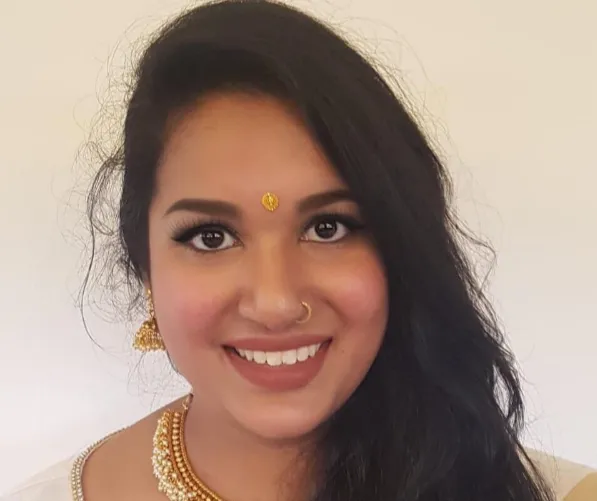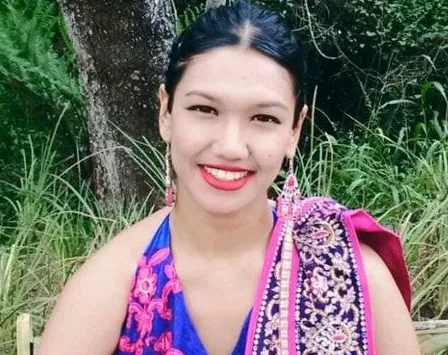Christian TikTok user warns against the 'stiletto challenge' linked to Lord Ganesha
BACKLASH

A screenshot of the video posted by a TikTok user, in which she referred to the Hindu deity, Lord Ganesh, as a ‘lower-case g’ God.
Image: TikTok
A RECENT video shared by an American TikTok user urging Christians to refrain from partaking in the viral “Nicki Minaj Stiletto Challenge” as it was linked to the Hindu deity, Lord Ganesha, has garnered significant backlash.
The challenge has seen women and men from around the world using stilettos or other high-heeled shoes, in a squatting position with one leg crossed over the other, while balanced on stacked objects such as cups, books, gym weights, and even bottles of nail polish.
The trend is seemingly inspired by a music video from more than a decade ago.
In the music video, musician Nicki Minaj, who is using high-heeled shoes, poses next to a pool in a squatting position, with one leg crossed over the other. However, both her feet are touching the ground.

A video screengrab of Nicki Minaj's pose in the video.
Image: Videoscreengrab
Last week, a TikTok user “Kayla Marie Gabbard” posted a video which has taken the challenge in a new direction, sparking much debate.
In the video, in which she also has a greenscreen in the background of Lord Ganesh, Gabbard said: “I know it is trending, but it doesn't mean it is right. Make sure if you are a Jesus following Christian, don't do this.”
Gabbard said it is different if you are Hindu, and practice the religion.
“But if you are a Christian, and you are out here posing like ‘lower-case g’ Gods, it is going against Jesus Christ.”
Gabbard goes on to tell Christians that they cannot participate and have anything to do with other Gods.
“The Bible says, ‘come out from among them, you are to be set apart’. You ain't supposed to be doing the same things they are doing. It is a trap and so many people are falling for it. Be careful of these trends, make sure you know what you are doing and why you are doing it and if it has anything to do with Jesus Christ or not.”

Sivani Chinappan Moodley.
Image: Supplied
Reaction
Sivani Chinappan Moodley, an international performing artist, choreographer and cultural activist, said the challenge had nothing to do with religion but more about balance, core strength and focus on breath energy.
She said the pose or posture depicted in the greenscreen is of a dancing version of Lord Ganesha.
“It stems from the Nadaraja pose. Many artistic impressions of God in dancing form have been created, following the ancient sculptures of 108 Karnas found in Sivan temples of South India.
“However, if this trend was in fact a pose of Lord Ganesha then specific hand gestures (mudras) would have been included, in addition to crossing one specific leg over the other (usually left over right),” she said.
Chinappan Moodley said personal prejudice, cultural and social influence, prevent the TikTok user from understanding the concept that Lord Ganesha is a representation of a functional aspect of God.
“Many people all over the world believe that Hinduism has many Gods, lending to derogatory statements being used loosely, like, ‘lower-case g’ Gods. Rig veda states in Book 1, verse164, hymn46 when translated, ‘Truth is one, but the men know it as many; God is one, but we can approach Him in many ways’. Further supported by Thirumanthiram verse 2104 when translated means, ‘One humanity, One God’.”
Chinappan Moodley added that the action of the TikTok user was not religious intolerance, but rather ignorant.

Saranya Devan.
Image: Supplied
Saranya Devan, a dancer, choreographer and Tamil activist, said the TikTok user purposely chose the image of Lord Ganesh in the dance pose.
“If you google Lord Ganesha you will see that he is usually in a seated position. In addition, during my many trips to India, I have seen images of Lord Ganesh in various poses including holding instruments. So this user has chosen to use this picture to demonstrate what she is trying to portray to whomever she is trying to reach.
“In addition, by saying ‘lower-case g’ God, I believe is definitely blasphemy, and sends out a message that no other religion is as important. I believe this is disrespectful of others beliefs.”

Tashmica Sharma
Image: Supplied
Tashmica Sharma, an executive member of the South African Hindu Maha Sabha(Sahms), said the religious institution condemned the “sacrilege, irreverence, religious defamation and discrimination” shared in the video.
“The Sahms further views this offensive misrepresentation as an opportunity to dispel misconceptions about Hinduism.”
Sharma, who is also vice-president of the Shree Sanathan Dharma Sabha of SA, said Sanathan Dharma (eternal religion or law) was not polytheistic, but rather a monotheistic faith.
“This means that it recognises one God who can take a limitless number of names and forms – centred on the One Supreme Reality, Brahman, described in the Vedas as both formless (Nirguna Brahman) and with form (Saguna Brahman), manifesting according to the spiritual inclinations of Hindu devotees.
“In this instance, Lord Ganesha is revered as the remover of obstacles and a symbol of wisdom, with the pose in the video reflecting yogic and meditative depictions found in Hindu tradition,” she said.
Sharma said while their overall view of the challenge was that it is non-offensive, the commentary posted by Gabbard, in which she refers to Lord Ganesha as a “lower-case g” God, was blasphemous and unacceptable.
“In doing so, she sows seeds of division and religious intolerance between faiths, contradicting the spiritual tenet of Vasudhaiva Kutumbakam, which declares ‘the world is one family’ in Sanathan Dharma.”
Sharma added they condemned religious bigotry and faith-based prejudice in the constitutional democracy of South Africa.
“Such rhetoric undermines the principles of respect, social cohesion, interfaith harmony and religious tolerance, enshrined in our nation’s values. We therefore welcome and encourage interfaith dialogues to dispel ignorance, promote understanding, and foster unity among communities. In this spirit, we encourage communities to see this as an opportunity to understand the inclusive ethos and the depth of universal teachings in Hinduism.”
Dr Lokesh Maharajh, chairperson of the Sahms’ Priest Council, said: “The person in the video is sharing her personal beliefs, but this could give people the wrong idea about both the dance challenge and the Hindu religion.”
He said referring to other people’s Gods as having a ‘lower-case g’ might sound disrespectful to those who follow that faith.
“Even if someone is speaking from their own faith, words like this can cause misunderstandings and make people less accepting of each other’s beliefs.
“Additionally, in a country with many religions, it is important to respect each other and speak carefully so we do not hurt or insult anyone. Respect and understanding help everyone live together peacefully,” he said.
Ashlin Ellan, youth committee chairperson of the Hindu Unity Forum of South Africa, said the remarks were deeply concerning.
“It is not concerning because of the challenge itself, but because of the way in which our sacred figure has been misrepresented and used as a backdrop for personal religious commentary.
“Lord Ganesha holds profound spiritual significance in Hinduism as the remover of obstacles and the deity of wisdom, intellect, and new beginnings. Linking a light-hearted or potentially risky viral trend to a sacred religious symbol without context or consent can be seen as disrespectful, and it trivialises a figure deeply revered by millions of Hindus globally,” he said.
Ellan said referring to people posing like “lower-case g” Gods was particularly problematic.
“This wording not only diminishes the sanctity of Hindu deities but also subtly perpetuates the notion that non-Abrahamic faiths and their divine figures are somehow ‘lesser’ or ‘false’,” he said.
Ellan said he believed there were elements of religious intolerance in the video.
“The TikTok user has not only misinterpreted a Hindu image for her own narrative but has also implied that engagement with our religious iconography is inherently wrong unless you belong to our faith - all while making derogatory distinctions between ‘their’ God and ‘other gods’.”
“As youth, we have the responsibility to stand against such misrepresentations, to educate others about our faith, and to advocate for respectful dialogue across communities. Our diversity should be our strength, not a source of conflict,” he said.
Related Topics: